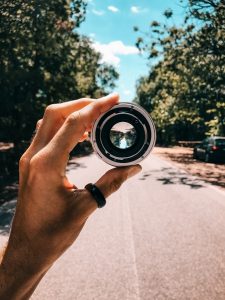
 Photo by Oleg Magni from Pexels
Photo by Oleg Magni from Pexels
I chose this image because it connects to how I imagine my research in a number of ways. The first connection is fairly obvious, and that is the lens. To start with the lens illustrates my new understanding of research as I, like many of you, came from a place of understanding “good research “to be clinical and quantitative; if you look closely you will see that the image within the lens is flipped. This connects to my flipped (new) understanding of what research can be. I now know that good research comes in many forms. This lens also allows me to look closer at something, to look deeply into something to gain a new insight or understanding. It allows me to see things in a new light, from a new angle; a new viewpoint. It also gives me the ability to put it down, to look around, walk around, turn around, breathe in the air, feel the air, and then zoom in on something.
“This looks interesting, let’s take a closer look at it.
I also think the lens allows for examination without judgement. This in turn opens up the possibilities and allows for new knowledge and understandings. This naturally connects to the idea that this lens can be used to explore research from each of the 4R’s (the research, the researcher, the researched and the reader); these would be different filters/ lenses.
I made two other connections to this image. The first connection is to the road; to the journey. The feeling I had when I first looked at this image was that this was the beginning, the beginning of a journey. This is where I am; at the beginning of my new research/teaching journey, at the beginning of my journey through this program, and its exciting. The second connection I made with this image was with the trees. In fact, when I first started looking at images, I was looking at trees; trees with roots that were deep and intertwined. This to me illustrates the intertwining and connectedness of ideas, the messiness that can come with research and teaching, the intertwining of different methods, of relationships, and the beauty of all of these, and perhaps if you were to close your eyes, you could imagine me moving the lens in that direction and zooming in to see this beauty.
The persistent idea I will carry forward, is that of the lens, both within my teaching practice and within my research journey in this program over the next two years. This idea of looking from many angles, zooming in and then out, trying on different filters, different viewpoints and then putting the lens down, looking around, seeing, touching, listening and then pulling it up again. Within my practice I may be thinking…is that what the student needs or is that what I think they need? I may be thinking… It’s always been done this way; but maybe there’s a new way, a different way or a way to blend ideas together. I may be thinking this can’t be done…but maybe it can, what else can I look at, who else can I talk to? So ultimately, I want to use these ideas and new understandings to continue my journey and further build my practice by exploring the use of further technology within my classroom, cross-curricular teaching, inquiry, and problem-based learning. I want to use this lens as a tool to guide me as I work towards reaching my goal of preparing students for the future. As Tom Whitby said, “We as educators need to shift the education dynamic of teaching kids what to learn to teaching kids how to learn. This is the best way we can provide for them a way to live in their world and not ours.”